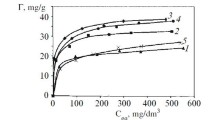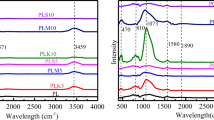Comprehensive decontamination of natural and waste waters from various chemical pollutants is a critical problem so that the development of new sorbents has high scientific and practical value. Heat treatment of sapropel—bentonite-clay mixtures could produce a bifunctional carbon-mineral sorbent that acted simultaneously as a sorbent for polar and nonpolar species. IR spectroscopy, elemental analysis, and combined thermal analysis (TG-DSC/DTA) found that the sapropel organic component was practically completely removed at carbonization temperatures 600 and 700°C. The release of volatile products gave the sorbent a porous structure and also altered the surface composition and properties. Mixtures carbonized at these temperatures had comparable amounts of organic and inorganic components.










Similar content being viewed by others
References
I. V. Glazunova, A. V. Synkov, et al., Izv. Vyssh. Uchebn. Zaved., Khim. Khim. Tekhnol., 51, No. 2, 94-96 (2008).
L. N. Adeeva and T A. Kovalenko, RU Pat. 2,523,476, July 20, 2014, “Method of obtaining carbon-mineral sorbent from sapropel for purification of water from multi-component pollutions”; Byull., No. 20.
Yu. V. Tishchenko, I. V. Glazunova, et al., Russ. J. Phys. Chem. A, 81, No. 6, 978-981 (2007).
V. B. Dobretsov, Sapropels of Russia: Development, Use, Ecology [in Russian], Giord, St. Petersburg, 2005, 200 pp.
E. A. Bannova, N. K. Kitaeva, et al., Sorbtsionnye Khromatogr. Protsessy, 13, No. 1, 60-68 (2013).
D. S. Orlov, L. K. Sadovnikova, and N. I. Sukhanova, Soil Chemistry [in Russian], Vysshaya Shkola, Moscow, 2005, 561 pp.
V. A. Smolko and E. G. Antoshkina, “Chemical and thermogravimetric analysis of bentonite clays from Greece and Wyoming (USA) deposits” [in Russian], Nauka YuUrGU: in: Proceedings of the 67th Scientific Conference, Natural Sciences Section, Izd. Tsentr YuUrGU, Chelyabinsk, 2015, pp. 321-328.
B. N. Tarasevich, IR Spectra of Principal Classes of Organic Compounds. Reference Materials [in Russian], MGU, Moscow, 2012, 55 pp.
E. Pretsch, P. Buhlmann, and M. Badertscher, Structure Determination of Organic Compounds. Tables of Spectral Data, Springer-Verlag, Berlin, Heidelberg, 2009, 443 pp.
D. S. Orlov, Humic Acids of Soils and General Theory of Humification [in Russian], MGU, Moscow, 1990, 324 pp.
S. Piotrowski, J. Therm. Anal. Calorim., 57, 527-540 (1999).
G. A. Kovalenko and L. N. Adeeva, Chem. Sustainable Develop., 18, 189-195 (2010).
Author information
Authors and Affiliations
Corresponding author
Additional information
Translated from Khimicheskie Volokna, No. 5, pp. 26-30, September—October, 2018.
Rights and permissions
About this article
Cite this article
Zykova, I.V., Isakov, V.A. Preparation and Study of Carbon-Mineral Sorbents Based on Novogorod Sapropel. Part 1. Fibre Chem 50, 408–413 (2019). https://doi.org/10.1007/s10692-019-09999-y
Published:
Issue Date:
DOI: https://doi.org/10.1007/s10692-019-09999-y




